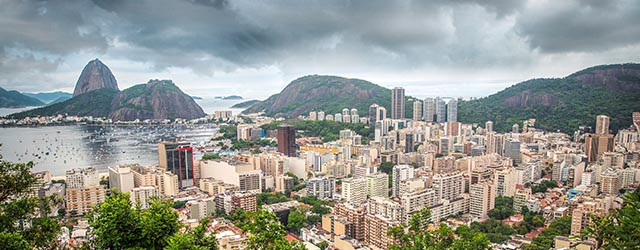Several of the region’s economies are gasping for breath or treading water—but not going under. Investors have simply discounted the bad news.

After shrinking by an estimated 0.3% last year, aggregate GDP in Latin America and the Caribbean will continue to contract in 2016, albeit at a smaller rate, according to the IMF, as the region weather its worst economic gale since the debt crisis of 19821983.
Latin America GDP Growth | ||
|---|---|---|
|
Country/Region |
2015 |
2016* |
|
Argentina |
1.5 |
-1 |
|
Brazil |
-3.8 |
-3.5 |
|
Chile |
2.1 |
2.1 |
|
Colombia |
3 |
2.7 |
|
Mexico |
2.5 |
2.6 |
|
Peru |
2.7 |
3.3 |
|
Venezuela |
-10 |
-8 |
|
Central America |
3.9 |
4.2 |
|
Latin America & Caribbean |
-0.3 |
-0.3 |
|
World |
3.1 |
3.4 |
| * projected Source: World Economic Outlook, World Bank, January 2016 | ||
The good news is that the tepid performance has already been priced in. Latin America has been forced to finally face up to a long list of much-needed economic reforms. And, for some, the region is still a great place to invest.
“Latin America is the single most attractive region,” says Jan Dehn, head of research at Ashmore Group. “Its commodity-related sectors are now very cheap, its currencies are now very attractive, and we should see a pickup in its net exports this year.”
Investors are eyeing Mexico, Central America and the Andean countries in particular. Even Brazil, mired in its worst crisis since the Great Depression, will attract an estimated $60 billion in foreign direct investment this year.
The challenge is to look beyond a kaleidoscope of negatives, ranging from the impact of China’s slowdown and the end of the commodities boom to a sluggish US recovery, world financial volatility and even a troublesome El Niño—which is bringing floods, drought and a crop shortfall.
Daniel Titelman, director for economic development at the United Nations Economic Commission for Latin America and the Caribbean (Eclac), says that, faced with this onslaught, Latin American’s “main regional challenge is how to recover a path to growth in the context of lower fiscal and monetary fat, less intraregional dynamism and major uncertainty in international financial markets.”
There are significant variations from country to country, and the United States is key.
“So far from God and so close to the US,” former Mexican president Porfírio Díaz liked to say of his country. Mexico, though, is currently surfing the American recovery wave, however modest. The country has also moved forward with positive domestic reforms, and its trade indicators show minimal fallout from the slowdown in China. But Mexico, along with Ecuador, Colombia and Venezuela, is also being squeezed by a loss of revenue from declining oil prices and curtailed production.
The risks of oil prices falling even lower in 2016 and of an economic slowdown in the US are real and threatening. Mexico’s economy is now expected to grow 2.6% this year—down 0.2 percentage points from the last forecast in October.
Central American countries are also enjoying ripples from growth in the US, and for them, lower oil costs are more of a boon than a bane. This subregion, which has been marked by increasing violence, has traditionally been the poorest in Latin America. It is projected to grow by 4.2% in 2016.
South America has been hard hit by China’s woes and their negative effect on oil, food and mineral prices and financial volatility. Brazil, Argentina and Venezuela also face inflationary pressure, limiting the range of fiscal and monetary solutions at their disposal and eroding consumer and investor confidence. Government macroeconomic mismanagement has also damaged fundamentals.
The reason China remains such a huge question mark for the region is twofold: Not only is China the destination for most Latin American exports, but it has also become in recent years an easy source of credit for governments and firms.
“China is like a parallel IMF,” says João Augusto de Castro Neves, Latin America director at Eurasia Group. So spillover from lower-than-expected Chinese economic activity could cause serious trouble. The World Bank estimates that a deceleration of one percentage point in China’s growth reduces expansion in Argentina by 1.9 percentage points—and in Brazil and Peru by 0.5.
The Andean nations—Chile, Colombia, Peru and Bolivia—despite their dependence on mineral and energy commodity exports, mainly to China, are in better shape, largely because of steps they took back when prices were booming. They have fiscal buffers in place and stronger macro foundations to support modest economic growth.
Colombia’s peace agreement with the FARC guerrilla group last year could brighten the outlook for business and investments, somewhat offsetting lurking uncertainty around oil prices.
Peru’s presidential elections in April should pave the way for the approval of key reforms and additional direct investment in that country.
Bolivia, currently the darling of the IMF and the World Bank, has built up substantial levels of domestic savings and international reserves. The country’s main worries are low gas prices and decreased demand for that commodity from Argentina and Brazil.
The next round of domestic economic measures to be announced by Latin American countries may offer the most precise barometer so far for the extent of adjustments in regional projections, government policies and investment decisions.
“In order to face [the region’s] challenges, Latin American countries must deal with their short-term agendas and, at the same time, protect their public and private investments,” says Titelman.
BLACK SHEEP

South America’s Brazil and Venezuela are currently the region’s black sheep. Their economic performances and domestic fundamentals have pulled regional growth statistics downward.
“Venezuela is a case of economic and institutional destruction. This year there is only a simple question: When is Venezuela going to default?” says Michael Gavin, global macro strategist for Barclays.
But for Gavin, the Venezuelan crisis is not quite as interesting or complex as Brazil’s. “In Brazil uncertainty around the monetary and inflation outlook, and the political crisis, are tied together, along with an extremely difficult budget situation,” he says.
In January the IMF revised its growth projections for Brazil to negative 3.5%, versus negative 1% last October. Many consulting firms are working on the assumption of negative 4% growth.
A political battle could lead to the impeachment of president Dilma Rousseff, with the uncertainty casting a pall over the country’s economic future. Consulting firm MB Associados predicts negative 4.1% GDP growth in 2016 if Rousseff remains in power, and negative 3% is she is legally replaced.
Bad blood between the Brazilian administration and its main political base in congress makes any legislative approval of badly needed fiscal measures unlikely.
Investors are likely to view corruption investigations related to Petrobras and private construction firms as improving the rule of law in the medium term. Over the short term, however, the scandal is damaging economic activity and compromising political maneuvering. After years of mismanagement, the country needs to meet its economic target—positive 0.5% growth in GDP by the end of 2016—and develop a plan to reduce debt, which is projected to reach 68.4% of GPD this year.
Experts differ on Brazil’s outlook.
Otaviano Canuto, Brazil’s representative on the IMF board, believes that recent fiscal reforms will be ratified. The measures, including reviving the bank transaction tax, could help the government tackle structural impediments to growth.
But Carlos Kawall, chief economist at Banco Safra, says heavier taxes won’t solve the Brazilian crisis. “The main issue is how the private sector should resume its investment,” he says. He doesn’t see a recovery taking root until 2017, predicting growth that year of positive 0.2%.
Meanwhile, the country muddles on. A decision on private investment has stalled, and public investment has been compromised by rounds of fiscal cuts. Brazil’s interest rate is at its highest level since 2006, with little signs of slowing. The manufacturing sector is shrinking—down 4.5% in 2016, according the National Confederation of Industry, after 8.3% growth in 2015. The nation’s biggest companies are deeply indebted and have few credit sources. Unemployment is expected to rise to 13.0% this year from 6.8% in 2015.
On the bright side, says Ashmore’s Dehn, “I think inflation falls this year and that Brazil gets a current account surplus, which shores up reserves.” Dehn’s assessment is in line with official expectations of a 7% rise in consumer prices by the end of the year, after an annual 10.7% increase in 2015.
As for Argentina, hope is in the air. Dehn sums up a number of positives. Since December, he says, the country has gone from having the second-worst government in South America (after Venezuela) to having, quite simply, the best one.

New president Mauricio Macri has motivated his economic team to restore Argentina’s macroeconomic balance by adopting a flexible currency policy, devaluing the peso, reducing subsidies and easing tariffs for agribusiness exporters. Macri, who took office in December, is also working hard to complete long-awaited deals with holdout investors that will restore Argentina’s access to international financial markets and encourage domestic and foreign investment.
Eclac’s Titelman, however, cites uncertainty around fiscal reforms and the impact of price subsidy reductions on Argentina’s fragile fiscal situation, given inflationary expectations.
“The effect of the peso devaluation has to be decanted. We must wait and see how the world economy evolves and if the changes in Argentine relative prices can result in more investment and activity,” he says. The IMF sees Argentina’s GDP contracting 1% this year.
Although buffeted by the same global trends affecting all nations, many Latin American countries are enacting reforms and restructuring. These moves, with attractive pricing, will continue to draw investors.
Two Nations, By The Numbers | ||
|---|---|---|
|
Projections for 2016 | ||
|
Brazil |
Mexico | |
|
Inflation |
7% |
3.30% |
|
Fiscal Primary Balance * |
-0.9 |
-0.5 |
|
Gross Public Debt * |
68.4 |
52.1 |
|
Current Account Balance * |
-2.66 |
-2.4 |
|
Foreign Direct Investment |
$60 bn |
$25 bn |
|
International Reserves ** |
$369.8 bn |
$175.4 bn |
|
Unemployment Rate |
13% |
4.5% |
* percent of GDP
** as of Jan. 31, 2016
Sources: Brazilian Central Bank, IBGE, IMF, Bank of Mexico, CEFP, Ministry of Finance of Mexico



